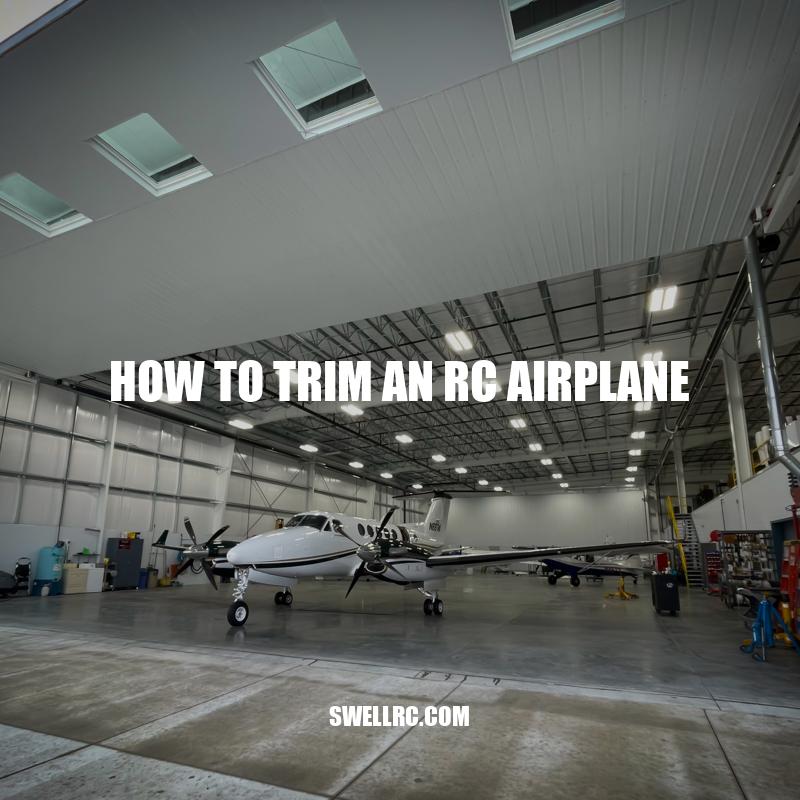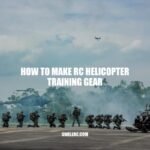Trimming Your RC Airplane: A Comprehensive Guide.
Flying an RC airplane is an exhilarating experience that comes with its share of challenges, especially when it comes to attaining the perfect flight. One challenge many pilots face is trimming their airplane for optimal flight control and stability. Proper trimming involves adjusting the plane’s elevator, rudder, and aileron controls to ensure that the plane remains stable and controllable in flight. Understanding and mastering the art of trimming is an essential part of a pilot’s skillset, whether you are a beginner or an experienced flyer. In this article, we’ll take a close look at how to trim an RC airplane, exploring everything from how to set initial trim to common trimming issues and advanced techniques for optimizing airplane performance. With a solid understanding of the techniques and tools involved in trimming an RC airplane, you’ll be on your way to achieving the perfect flight every time.
Understanding Trim Controls
RC airplanes come with three primary trim controls – the elevator, rudder, and aileron. Each serves a specific function, and mastering the art of making small and precise adjustments to each is critical. Here’s a quick overview of what each control does:
- Elevator: The elevator controls the pitch of the airplane, or its angle of ascent or descent in the air. Adjusting the elevator trim can help the plane maintain its altitude and prevent it from climbing or falling uncontrollably.
- Rudder: The rudder controls the yaw, or left and right movement, of the airplane. Making small adjustments to the rudder trim can help keep the plane flying straight and level and correct any drift to either the left or right.
- Aileron: The aileron controls the banking or roll of the airplane. Adjusting the aileron trim can help keep the plane level or turn left or right depending on the desired direction.
Understanding how each of these controls works and how to adjust them is critical for controlling your airplane’s flight. There are some great online resources such as RC aircraft and hobbyist forums and instructional videos that can provide detailed information for each trim control. There are also excellent simulators that can help pilots sharpen their trimming skills without the high stakes of crashing the plane.
What Controls Trim on an Airplane?
Trim is an essential component of an airplane’s control system. Proper trim is critical for a stable and safe flight. Here are the three main things that control trim on an airplane:
- Trim Tabs: These are small flaps located on the trailing edge of control surfaces such as the elevator, rudder, and ailerons. Trim tabs help pilots to adjust the aircraft’s pitch, yaw, and roll.
- Stabilizer: The stabilizer is the fixed horizontal surface at the tail of the fuselage. It helps to stabilize the airplane in pitch, and its angle can be adjusted to change the aircraft’s trim.
- Trim Wheels: These are located on the control columns or yokes. Rotating the trim wheel adjusts the pitch and roll trim of the airplane.
Proper trim can be achieved by making small adjustments to any of these components. To learn more about airplane control systems, visit the Federal Aviation Administration website.
Trimming Before Flight
Before launching an RC airplane for the first time, you’ll need to ensure its basic trim settings are correctly adjusted according to your plane’s specifications. Here are the steps to take before heading to the runway:
- Check the CG: Verify that the plane’s center of gravity is correct by using a CG tool or using the recommended position suggested in the owner’s manual, and then making adjustments if necessary.
- Battery placement: Make sure the battery pack, servos, and any other installed parts are all properly placed and balanced. A weight imbalance will disrupt the plane’s trim and cause erratic movements during flight.
- Check your control setup and radio: Before getting it in the air, make sure that all the controls move in their correct directions and that you have set-up the controller to trim the appropriate direction.
- Make small adjustments: With the battery and receiver installed and properly balanced, and after making sure all control surfaces move in the right direction, make small adjustments to each control surface while the airplane is on a level surface.
| Control Surface | Adjustment Direction |
|---|---|
| Elevator | adjust up or down to make it fly straight and level |
| Aileron | adjust left or right depending on the plane’s turning direction during flight |
| Rudder | adjust left or right to keep the plane’s yaw aligned with the runway centerline |
Taking the time to trim the plane before takeoff will make all the difference during flight, particularly for novice pilots. There are several great instructional videos and websites available for beginner and advanced RC pilots on trimming skills such as Flite Test, RCGroups, and RC Universe.
How do you fly an RC plane for the first time?
If you’re new to flying RC planes, here are some basic steps to get started:
- Start with a trainer plane, which is specifically designed to be easy to fly for beginners.
- Find an open, spacious area with little to no wind.
- Make sure your plane’s batteries are charged and the controls are working properly.
- Takeoff: Increase the throttle and launch the plane into the air gently.
- In flight: Use your right-hand control to steer the plane left and right, and use the left-hand control to control the throttle and altitude.
- Landing: Reduce the throttle and gently bring the plane down to the ground.
Before you take off, make sure to read the manual carefully and watch tutorial videos to get a better understanding of flying tips and tricks. You can also check out websites like RCGroups.com for more information and community forums.
Adjusting Trim in Flight
Even with proper pre-flight trimming, wind and weather conditions can cause issues in the middle of a run. Here are some tips to help you adjust the trim while in flight:
- Stay calm: If you notice that your plane is flying erratically, take deep breaths and stay calm. Panic will only make it worse.
- Identify the problem: Be aware of the warning signs of a poorly trimmed airplane, such as difficulty maintaining altitude, banking to one side, or not staying in a straight line.
- Making small adjustments: When making midair adjustments, only make small changes; too many can worsen the situation.
- Use Proportional Control: Make small adjustments and wait for your plane to recover before making further adjustments, similar to the PID concept (Proportional, Integral, Derivative)
While adjusting plane trim during flight presents a certain level of risk, you can minimize those risks through practicing in good weather conditions with enough altitude to recover. Professional pilots recommend practicing these techniques in a simulator before attempting to make them of the open air. There are a lot of helpful instructional videos and websites available for beginner and advanced RC pilots on trimming skills such as Flite Test, RCGroups, and RC Universe.
How do you control trim on an aircraft?
The primary purpose of aircraft trim is to help the aircraft maintain a stable and controlled flight. It controls the force on the control surface and makes minor adjustments to the plane’s angle of attack. Here’s how to control trim on an aircraft:
- Trim tabs: These small surfaces on the trailing edge of the elevator, rudder or aileron provide a small continuous force to change the angle of the control surface.
- Electronic trim: Modern aircraft use electric motors to adjust the position of the entire control surface, which is done by pressing buttons on the control panel.
- Manual trim: In older aircraft with mechanical controls, pilots must use a manual wheel or lever to adjust the cable tension and control surface position.
For more information about aircraft trim, you can check out aviation websites like AOPA.org or FAA.gov.
Common Trimming Issues
Sometimes even the most experienced pilots face some common trimming issues in RC airplane flying. Here are some of the most common trimming issues and how you can solve them:
Issue 1: Uncontrollable Turn
- If your plane is turning uncontrollably even with the rudder stick neutral, this indicates that your ailerons are not aligned correctly.
- Center your ailerons by using a ruler to measure for alignment from wingtip to wingtip.
Issue 2: Difficulty Maintaining Altitude
- If you’re having trouble maintaining altitude, this indicates that your elevator (found on the tail of the plane) isn’t set correctly.
- Adjust the elevator in small increments (up or down) and take note of how the airplane performance changes.
Issue 3: Pulling to One Side
- If your plane pulls to one side when flying, this is a sign that the airplane is unbalanced.
- Check for cockpit placement, wing struts, and battery placement within the body of the plane. These can cause an uneven distribution of weight and cause your plane to pull to one side.
- Adjust your plane’s center of gravity (CG) by moving lead weight in the nose or tail of the airplane to maintain stability.
By identifying some of the common trimming issues that pilots face, you’ll be able to get started on troubleshooting and solving those issues. Don’t be afraid to reach out to other experienced pilots or RC forums online for guidance. Additionally, there are numerous websites available to help you resolve trimming issues such as RCPlaneViews, Flite Test and Model Aviation.
What condition results when the airplane has been properly trimmed?
When the airplane has been properly trimmed, it is in a stable condition with minimal pilot input needed to maintain its altitude and heading. The airplane will fly straight and level without any climb or descent, and there will be no tendency to roll to the left or right. This makes it easier for the pilot to control the airplane and reduces pilot fatigue.
If you’re interested in learning more about aviation and aircraft control, check out websites like AOPA or Aviation Theory.net for comprehensive information and resources.
Advanced Trimming Techniques
For those pilots who are ready to take their trimming skills to the next level, there are several advanced trimming techniques to consider:
Technique 1: Differential Aileron Mixing
- This technique involves using the radio transmitter to mix the ailerons so that the upward-moving aileron moves more than the downward-moving aileron.
- This creates a drag effect that slows down one wing while speeding up the other, allowing for smoother and more precise turns.
Technique 2: Flaperon Mixing
- This technique involves using the transmitter to mix the aileron and flap controls together to create a real-time spoiler effect.
- The spoilers minimize lift on the wing and helps to reduce speed and altitude. This technique is perfect for landing and slow flying.
Technique 3: Throttle-to-Elevator Mixing
- This technique involves integrating radio power and throttle control with elevation on the tail of the plane.
- As you increase the throttle, the airplane gradually pitches up until it reaches maximum throttle, and then gradually pitches back down.
By implementing these advanced trimming techniques, you can achieve even more precise control over your airplane’s movements and get the most out of your RC airplane flying experience. Several websites offer more information on these techniques and can provide you with the guidance you need to implement them effectively, such as RCTraner, RC Groups, and RC Universe.
What does differential aileron do?
Differential aileron is a technique used in aviation to create a yawing moment that counteracts the adverse yaw produced by aileron deflection. Here’s what it does:
- Increases lift on the upward-moving wing and reduces lift on the downward-moving wing, improving roll control.
- Reduces the amount of drag produced by the downward-moving wing, reducing the risk of stalling.
- Reduces the amount of adverse yaw, the tendency of an aircraft to yaw in the opposite direction of the intended turn due to unequal lift.
Understanding how differential aileron works is useful for pilots, especially those who fly aircraft with large wingspans or low aspect ratios. If you’re interested in learning more about aviation, check out aviation websites like AOPA or aviation products like Microsoft Flight Simulator.
Conclusion
As a new pilot, trimming an RC airplane might seem like a daunting task, but it’s an essential process that could make all the difference in your flying experience. By following the steps outlined in this article, you should be able to achieve the optimal stability and control needed for your airplane to fly smoothly. Remember, a well-trimmed plane flies effortlessly and will boost your confidence as a pilot.
If you encounter any difficulties while trimming your RC airplane, don’t hesitate to seek out advice online from experienced pilots. There are several online forums such as Reddit and RC Forums, where you can post a question and get answers from seasoned pilots.
Whether you’re just starting as an RC airplane pilot or have been flying for years, proper trimming is a crucial aspect of flying any RC airplane. With the right knowledge, experience, and techniques, you’ll be able to make the most out of your airplane flying experience. Happy flying!



